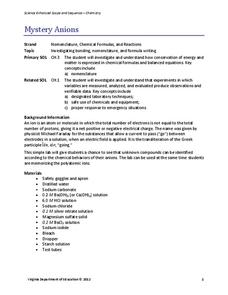Virginia Department of Education
Mystery Iron Ions
Young chemists perform an experiment to determine if a compound is iron (II) chloride or iron (III) chloride. Then they determine the formula, balance the equation, and answer analysis questions.
Curated OER
Dental Chemistry Analogy
After taking in background information on teeth, marble, eggshell, and fluoride, chemistry aces design an experiment. Their goal is to demonstrate whether or not fluoride has a similar effect on marble or eggshell as it does on tooth...
Virginia Department of Education
Matter and Energy: Equations and Formulas
Using simple materials, an informative lesson plan demonstrates the Law of Conservation of Matter and explains how to balance chemical equations. Young chemists perform experiments, analyze reactions, and balance chemical equations on...
Virginia Department of Education
Equilibrium and Le Chatelier’s Principle
The best part of learning about equilibrium is that nothing changes. Young chemists observe four demonstrations during this instructional activity: equilibrium in a saturated solution, equilibrium with an acid-base indicator, equilibrium...
Curated OER
Oxidation Reduction
In this chemistry worksheet, students examine oxidation reduction in order to apply it in the laboratory setting. The sheet includes in depth background information.
Curated OER
Determination of the solubility product of silver(I) chloride
For this chemistry worksheet, students examine the concept of solubility of silver chloride. The sheet has in depth concept and laboratory instructions.
Curated OER
Balancing Chemical Equations
Ninth graders explain how atoms and molecules form different substances during chemical reactions and how these processes require losing, gaining or sharing electrons. They correctly write chemical formulas and show how a balanced...
Curated OER
Ionic Chemical Formulas Days 1 & 2
Students study polyatomic ions and write binary and ternary ionic chemical formulas. They explore putting together different monatomic ions and coming up with as many chemical formulas as possible. They play a game similar to memory...
Chymist
An Experiment in Alchemy: Copper to Silver to Gold
Use chemistry to change pennies into gold coins! The experimental procedure leads learners through the process of changing copper pennies to silver and then to gold. They record the mass of each coin through every step of the experiment.
Virginia Department of Education
Mystery Anions
Lost an electron? You should keep an ion them. Young chemists learn qualitative analysis in the second lesson plan of an 11-part chemistry series. After observing reactions of simple salts, the teacher provides pupils with unknown...
Curated OER
Redox Equations and the Half-Reaction Method
Students review half-reactions and practice balancing redox equations in order to help them solve problems in chemistry.
Curated OER
Micro-Magic With Sticky Ions
Students view a video about the formation of precipitates. They complete a worksheet that asks them to identify what makes a compound form and what holds it together.
Curated OER
What Are Mixtures And Solutions?
Young scholars explore mixtures and solutions. In this chemistry lesson plan, students will add different ingredients to jars in order to classify them as mixtures or solutions. There is also a nail balancing activity that can be done at...
NOAA
Off Base
How does carbon dioxide affect the world's oceans? The final installment in a series of six lessons has pupils research ocean acidification, then conduct an experiment to witness the delicate balance that exists in our seas. Materials...
Virginia Department of Education
Molecular Model Building
During this hands-on activity, young chemists build molecular models based on the Lewis dot structure before studying valence shell electron pair repulsion theory.
Curated OER
A Solution for Precipitation
Learners predict the product of chemical reaction using the solubility rules. In this chemistry lesson, students balance ionic equation. They perform a lab to check if their predicted products are correct.
Curated OER
Electroplating for Corrosion Protection: Redox in Action
Students define what a redox reaction is. In this chemistry activity, students electroplate some wires in the lab. They research the application of electroplating in the real world.
Curated OER
The Measurement Of Acids And Bases
Students investigate the differences in chemistry between an acid and a base substance. They conduct measurements based upon the pH scale and then answer the questions included in the lesson. The information for the lesson is included in...
Curated OER
Chemical Composition of American Coins
High schoolers investigate the chemical composition of pennies dated 1983 or later. In this chemical composition of American coins lesson plan, students scratch the surface of the penny to expose the zinc core. They put the penny in...
Curated OER
Precipitation and Neutralization Reactions
In this chemical reactions worksheet, students determine the balanced formula equation, balanced complete ionic equation, and the balanced net ionic equation for given reactions. Students calculate final concentrations for ions in given...
Curated OER
Types of Reactions (Demonstration)
Students visually observe chemical changes that occur when various solutions are combined. Teacher explains chemical reactions that are happening.
Curated OER
Chemical Reactions
In this reactions worksheet, students state the differences between a coefficient and subscript and an exothermic and endothermic reaction. Students review the different types of reactions. This worksheet has 13 short answer questions.
Virginia Department of Education
A Crystal Lab
Young chemists grow ionic crystals, metallic crystals, and supersaturated crystals in three different lab experiments. Observing these under a microscope allows pupils to compare the various structures.
Virginia Department of Education
Acids and Bases
What did one titration say to the other titration? We should meet at the end point! Young chemists perform four experiments: dilute solution, neutralization, titration, and figuring pH/pOH.

























